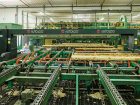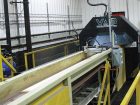
Features
Mills
Sawmilling
Tripling planer production
June 11, 2015 - When fire destroyed the Carrier and Bégin planer mill south of Quebec City in January 2013, owner Christian Carrier seized the opportunity to triple production.
June 11, 2015 By Alain Castonguay
Carrier became the sole owner of the mill on Jan. 31, 2011, despite what the sawmiller called a “difficult environment.” Two years later, in a scene made for televison, a former employee fired a week earlier returned to the site after a night of drinking, and set fire to the building. The losses were estimated at $6 million.
Very quickly, Carrier and his team rolled up their sleeves, and construction of new facilities was launched a few months later. Planing resumed in Saint-Honoré on Nov. 27, 2013, but Carrier waited a year to the day before inaugurating the facility, to ensure production was to his liking.
“I wanted to say to all our guests that I was happy with the equipment,” he says.
Some 150 people, including Canadian Forest Industries, joined Carrier and his wife, Julie Veilleux, at the official inauguration on Nov. 27, 2014. Carrier was visibly moved as he was treated to a standing ovation by the local crowd.
“As you know, I grew up in this business and in my heart knew I would take it over one day,” he told the crowd.
He added that once past the shock caused by the fire, he feared that they would be unable to find the required financing to rebuild the new planer mill after years of recession in the industry.
“We had the project to build a new planer mill anyway, but not on this fast a timeline,” Carrier explains.
After making the rounds to his partners, he launched the rebuild. The company has temporarily rented facilities at a mill in Saint-Benoît-Labre to continue planing to prevent any loss of staff or clients. The groundbreaking ceremony took place on April 22, 2013, less than three months after the fire.
Financing acquired
On the finance side, the company worked with the National Bank of Canada (NBC).
NBC’s Laurent Pelletier notes that the bank has continued to support entrepreneurs in the wood industry, despite the difficult markets since 2006. In fact, the bank had been part of Carrier’s succession planning when Carrier arranged to buy the mill. At that time, he confirms, the planer mill was already identified as a major bottleneck, and the facilities were outdated. After the fire, the bank did not hesitate to join in the financing package to rebuild the mill.
Also present during the inauguration was Saint-Honoré Mayor Dany Quirion, who spoke with great sincerity about his “personal friend” Christian Carrier, stressing that all council members were present at the inauguration.
“The municipality of Saint-Honoré has 1,650 inhabitants. We do not often get together to celebrate an investment of $10 million,” he said, emphasizing the mill’s importance to the local economy.
Locally supplied
The new building covers 42,000 square feet, and planing production has increased from 600 to 1,700 linear feet per minute, with a goal to go even higher. Much of the technology installed comes from a group of local suppliers in and around the Beauce region of Quebec. This industrial region south of Quebec City is well known for its entrepreunial spirit. Many were on hand at the opening to explain their respective roles in the rebuild.
“Carrier wanted to produce a wide variety of dimensions of pieces of wood for a mill this size, which brings its share of challenges,” explains France Gauthier, director of engineering at Piché Machinery, project manager for the rebuild.
The supplier is located in Daveluyville, in the heart of Quebec.
“We must separate the range species the mill saws, and they are not all processed or react the same way once sorted. Pine is gummy, cedar is abrasive, for example,” Gauthier explains.
Another key technology partner was RY Fabrication, a supplier from the South Shore of Montreal that specializes in planer mill equipment.
The company has designed and built its own resaws and planers since 2008. Sylvain Paiement, RY’s owner, explains that the main goal of Carrier & Bégin was to replace the 1960’s vintage equipment with more productive technology. The former planer ran at a peak of 700 fpm, while the resaw chugged along at less than 100 fpm, ripping 4’x4’s out of larger dimensions.
The resaw installed in Saint-Honoré is a new concept machine designed specifically for Carrier & Bégin. Using a circular saw, it now resaws at up to 700 fpm, while requiring far less maintenace than the old band saws. The precision is also better.
“Christian wanted us to brand this resaw the ‘Carrier.’ It’s a gem for them,” Paiement says.
A large part of Carrier & Bégin’s success is its ability to supply odd dimensions to unique markets, such as unusual dimensions ranging from 1’x3’ to 6’x6’.
Fully optimized
The rebuild also allowed the mill to enter the modern era of planer mill optimization. The selected technology allows the mill to extract the maximum revenue from all production, explains Simon Lebel of optimizer supplier VAB Solutions.
Defects such as bark residue and cracks are eliminated, while the highest value is extracted around the natural defects of each species.
Carrier & Bégin’s planer optimizer was the 22nd installed by VAB Solutions, a company founded in 2004 by Marc Voyer and Jean Bérubé. The system completely eliminated the need for graders at the mill.
Ramping up the optimizer production was an unusual challenge at Carrier because of the wide variety of products and species produced, more than 100 in total
Another local player involved in the rebuild was Logitex, specialists in sawmill controls and automation. It designed all of the mill’s control panels. Another relatively new player, Logitex was launched in 2006 just as demand for wood products fell in the U.S.
Since 2010, the company has specialized in equipment similar to that installed in Saint-Honoré.
“With the economy at the time, we did not have the luxury to diversify into different products,” says one of Logitex’s automation project managers, Yves Poulin.
“We work with mills who want completely automated proceses, where operators do the least possible handling, with fewer people, and more technology. We can be proud to have in the Beauce region a mill as well equipped as Carrier,” adds another Logitex automation project manager, Kenny Perron.
Signode district manager Sébastien Mercier ran Canadian Forest Industries through the sawmill equipment used to label and strap packages ahead of the kilns. Each piece has a unique code, allowing staff to consult inventory details to determine the nature of any problems that arise.
The Signode system keeps information on a million pieces, which can be traced back to days of production. For environmental certification, the old stamping systems were made of rubber, but with the higher production levels the mill has moved to an inkjet system. The Carrier & Bégin brand, or that of other private brand customers, is added to all pieces. If there is a problem with the system, a signal is sent to an operator. Packaging is fully automated.
Expansion challenges
The mill has future growth plans in the works, and is eying solutions to both space and staffing shortfalls. Carrier & Bégin is located in the town’s industrial park, and the site is a good size, with the lumber yard, drying and planer mill at the bottom of a field. Despite this, Carrier would like a little more space to add kilns and have more space for the lumber yard if he can add a second planer shift. This may not happen in 2015, “but in this industry it’s more fun to plan for growth than manage decline,” Carrier says with a smile.
Mayor Quirion confirms that the municipality will lend an ear to the mill’s needs, and is considering relocating neighbours a little further to allow the mill expansion.
“We are working to resolve the space problem,” he says.
The mayor will also support the company’s efforts to obtain the required permits – a refreshing attitude. However, staffing challenges are not so easily solved.
“If we add a shift, where where will we find the staff?” Carrier asks. “Everywhere in the Beauce, that’s everyone’s challenge. All the area plants have signs saying, ‘We are recruiting.’ We are looking for people who want to work, of course, like everyone else,” Carrier adds laughing.
Expansion challenges
The mill has future growth plans in the works, and is eying solutions to both space and staffing shortfalls. Carrier & Bégin is located in the town’s industrial park, and the site is a good size, with the lumber yard, drying and planer mill at the bottom of a field. Despite this, Carrier would like a little more space to add kilns and have more space for the lumber yard if he can add a second planer shift. This may not happen in 2015, “but in this industry it’s more fun to plan for growth than manage decline,” Carrier says with a smile.
Mayor Quirion confirms that the municipality will lend an ear to the mill’s needs, and is considering relocating neighbours a little further to allow the mill expansion.
“We are working to resolve the space problem,” he says.
The mayor will also support the company’s efforts to obtain the required permits – a refreshing attitude. However, staffing challenges are not so easily solved.
“If we add a shift, where where will we find the staff?” Carrier asks. “Everywhere in the Beauce, that’s everyone’s challenge. All the area plants have signs saying, ‘We are recruiting.’ We are looking for people who want to work, of course, like everyone else,” Carrier adds laughing.
Production
The planer mill runs 44 hours a week on a single shift, dressing the company’s own lumber as well as that of other area mills. In the sawmill, production is spread over 72 hours, from Monday morning until Saturday evening.
The company provides work for 80 people, 22 more than before the fire.
“Before, we had a shift of 43 hours at the sawmill, and two 36-hour shifts at the planer,” Carrier says. “Now it’s the opposite. So we have hired 22 people for the extra sawmill work.”
Between Dec. 1, 2013, and Nov. 30, 2014, the company produced almost 47 million bdft in balsam fir, spruce and red pine in commodity and custom sizes. For its last fiscal year, Carrier & Bégin had sales totalling 41.4 million bdft.
About 55 per cent of its fibre supply comes from private forests just over the border in Maine, while the rest is purchased in Quebec.
The company buys its wood within 160 kilometres of the plant.
“Supply is always a challenge. There is a lot of competition between mills,” Carrier says.
When business was going well in the south of the border, the company had delivered up to 85 per cent of its production into the U.S. “It now takes between 6 and 10 per cent,” Carrier laments. “The rest is sold in Quebec, Ontario and the Maritimes.
Optimization upgrade for sawmill
Carrier & Bégin worked with Autolog to replace its gang edger optimizer in the sawmill in 2014. The sawmill had previously worked with Autolog for the installation of three transversal optimizers at the sawmill for controlling the edger, the gang edger and the multi-saw trimmer in 1999, as well as the optimizers’ controls.
In January 2014, Autolog replaced the sawmill’s gang edger optimizer. One of the major challenges of the project was to measure perfect blocks, which meant no wane detection during the production of red pine. Very precise detection for the start of the wane, as well as the shape of pieces, was necessary in order to set the saws as required by the optimizer.
It was not possible to use the conventional method – which consists of positioning the scanners at 90° – to precisely measure the roundness of the cant due to the optical physical property of the laser diffraction on the wood. (When surpassing a certain angle, the information from the lasers does not come back to the camera and, therefore, generates imprecise readings.) So, Autolog proposed modifying the angle of the heads and redoing the algorithms so that the scanners send back as much quality data as possible to the optimizer without having to add additional sensors. The company’s solution was a success.
Print this page


